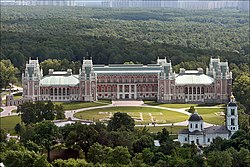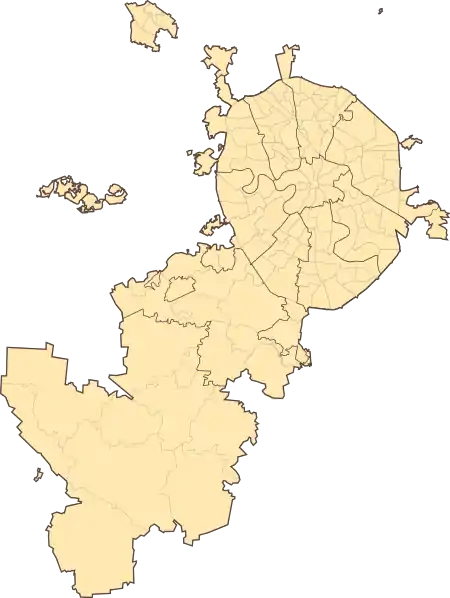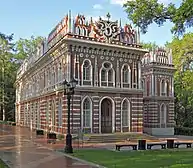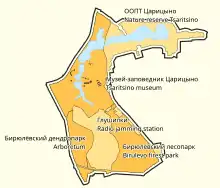Tsaritsyno Palace
Tsaritsyno (Russian: Царицыно, IPA: [tsɐˈrʲitsɨnə]) is a palace museum and park reserve in the south of Moscow. It was founded in 1776 by the order of Catherine the Great.
 | |
 Location within Moscow | |
| Established | 1775 |
|---|---|
The palace has lent its name to the surrounding district and the nearby metro station.
History

The estate is known from the late 16th century, when it belonged to Tsaritsa Irina, sister of Tsar Boris Godunov. At that time it was called Bogorodskoye. In the 17th century it belonged to the Streshnevs and then to the Galitzines.

In 1775, the estate was bought by empress Catherine the Great, who happened to be passing through the area and fell in love with the picturesque beauty of the land. It received its present name, which means “Tsaritsa’s”.
In 1776-85 architect Vasili Bazhenov built a palace for the Empress there. When the palace was almost complete, the Empress visited Tsaritsyno to inspect it. She declared the rooms to be too cramped and dark, and the palace unlivable. As a result, Catherine ordered the palace to be torn down. The remnants of the foundation of Bazhenov's original palace are still visible in the park.

In 1786, Matvey Kazakov presented new architectural plans, which were approved by Catherine. Kazakov supervised the construction project until 1796 when the construction was interrupted by Catherine's death. Her successor, Emperor Paul I of Russia showed no interest in the palace and the massive structure remained unfinished and abandoned for more than 200 years, until it was completed and extensively reworked in 2005-07.
Currently, in Tsaritsyno there are a history and architecture museum, a landscape park with an adjacent forest, an art museum, the Biryulyovo dendropark, and a cascade of the Tsaritsyno ponds. It is managed by the Tsaritsyno Museum Reserve, founded in 1984.
Park

The 18th-century architecture ensemble was built (though not finished) following the order of Catherine II in Neo-Gothic style, after projects of the Bazhenov and Kazakov, and it is the only 18th-century architectural ensemble of such dimensions in Russia.

Around the palace, in the park there are a number of pavilions, pergolas, arbours, artificial grottos, decorative bridges (early 19th century, architect I. Yegotov), and a Russian Orthodox temple “Source of Life”, as well as a modern recreation center with an upscale restaurant. For a long time most buildings were ruined (and used for rock climbing). In 2005-2007 most buildings were extensively restored and completed: roofs, interiors and decorations have been added and their historical appearance has been altered. A number of buildings house the Russian museum of folk and applied art. The atrium of the “Bread House” is used for concerts of Moscow musicians.
The park grounds contain a group of burial mounds (Kurgans) that belong to the Early Slavs tribe Vyatichs dated to the 11th-13th century.
External links and references
| Wikimedia Commons has media related to Tsaritsyno Park. |
- Official website (in English and Russian)
- Photo of Palace Complex and Park
- Reviews on TripAdvisor (in English and Russian)
- Tsaritsyno Park - One of the Best Museums in Moscow (in English)